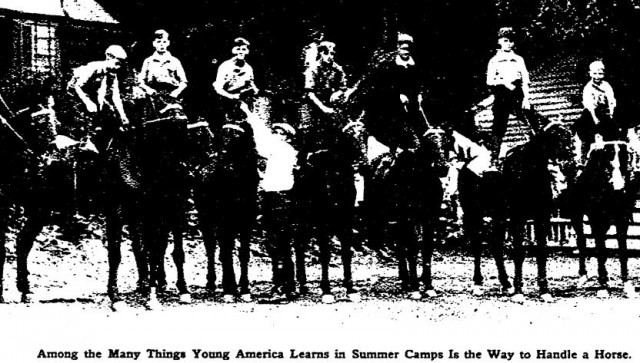A History of the New York Times, Summer Camp and Rich People
by Nate Hopper

Right now, many young summer campers are frolicking beneath the open sky, the wind on their faces perfumed by the rough fragrances of pine and their parents’ jet exhaust; on the horizon, the mountains shrug, “whatevs.” Their families will pay one-fifth of the median national household income so they can go “rough it.” And The New York Times has been on it.
The modern tales are ghastly — and not just that now-infamous tale of chartered planes and rural runways. Because of the economy, some owners have to deal with lower enrollment this year; in July, the Times told the story of one camp that hit only 98 percent capacity this summer, which is up from 95 percent in 2009, but down from 100 percent in 2008. “With enrollment at the three camps nearly full,” — the owner has two others — “the business over all remains profitable… but he does say that profit margins are narrowing in the face of increased expenses for new buildings and new programs, along with the rising cost of food and gas for water-skiing boats.” Ah, the pangs of expansion and water sports. And then there’s the not-so-dirt-under-your-nails-y, like Fashion Camp NYC and the one where goers design videogames, build robots and write code — which could be awesome, could be horrible.
This coverage of ritzy camps appears to be — according to a review of the archives dating back to 1923 — a new angle for the annual Times summer camp beat.
Sure, in 1950, they had a man opine about how television ruined the refined unrefined-ness of summer camp, saying, “too many camps are now glorified country clubs.” (Glorified, indeed.) And yes, they sometimes chronicled the expanding upper-limit prices of a prelapsarian escape to the wilderness during the ’60s and ’70s, calling some options “plush.”
But mostly the Times has — almost sadly, since it’s so fun to riff on — covered summer camp tragedies and safety measures, or spent ink raising funding for needy camps (as the Times has zealously done since that fateful day in 1911, when publisher Adolph S. Ochs “went out for a walk after a big turkey dinner, and encountered a shabbily dressed man on the street”) or the YMCA and the Boy’s Scouts (Girl’s Scouts less); it has provided guides for choosing between the many options (you know you’re supposed to start looking in the winter, right?) and proper outfitting.
In 1988, they published a story about free summer camps for homeless children between ages six and ten; and, of course, camp crops up in the Neediest Cases mini-profiles, such as this one in ’96; then, three years later, there’s this on the closing of a camp for disabled children.
In ’98 they wrote about New York City Schools Chancellor Rudy Crew’s idea to send 10,000 public-school kids to sleepaway camps in the Catskills (an oft-tried proposal: for instance, in 1936, the Times wrote about how the mayor wanted to “give 110,000 vacations” to kids — take that, Rudy). The idea has been a recurring theme for decades of the paper’s summer camp coverage and comprised most of the coverage of summer camps in the ’20s; in 1924, a piece included, “Every means of getting children into the country who otherwise would be condemned to a summer on the city’s pavements should be encouraged.”
In other decades, “camp” had a different meaning for the Times too, like in the 1940’s, when it was more closely synonymous with “military training.” And David Brooks recently became one of many to wax nostalgic about the camp he fell in love with: “I’ve never been to a place where race and class mattered less.”
At some point, things changed. Maybe the spiral always aimed downward, starting back when, in the paper’s first long feature on summer camp (at least the earliest one yielded by our search), in 1924, the reporter wrote that, “While the European father continues his Summer custom of taking his wife and children to the seashore, the American father has broken this habit and adopted new ones. He is more apt to take his wife to Europe or on a fishing trip and send his children to camp.”
Camps run by “philanthropic organizations and other societies… do not differ” in essentials “from the camp of the well-to-do child; the latter has only a few more frills,” the Times wrote then. And: “Camps for the medium purse offer practically the same recreational attractions as the deluxe camp.” To Europe! Not those who resided in the then-30-year-old tenement buildings of the East Village, after it was no longer Little Germany.
So the real turn in tone and focus is quite recent. Now our camp coverage, for whatever reason, has shifted from warning about over-crowded buses and trains to coverage of private jet ports. It seems to be a perverse sign of the — well, something or other.
Nate Hopper is a summer Awl reporter.
